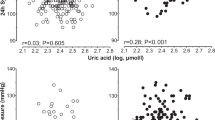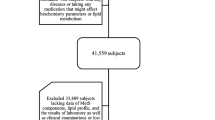Abstract
The African population is considered a high-risk group for the development of hypertension, and identifying risk factors are therefore essential in preventive actions against cardiovascular disease (CVD). Elevated levels of uric acid (UA) are often associated with CVD. Our first aim was to establish possible ethnic differences in UA levels between African and Caucasian men. Our second aim was to determine any associations between UA levels and cardio-metabolic variables, and also how these correlates differ between the two groups. African (N=87) and Caucasian (N=121) men participated in this cross-sectional study. Our results have shown that African men had significantly lower (353±87.7 vs 401±98.2; P<0.01) UA levels compared with Caucasian men. Waist circumference and triglycerides correlated strongly with UA in both ethnic groups. This was confirmed with a forward stepwise multiple regression analysis. After adjustment for confounders, the correlation between UA and triglycerides remained significant only in the Caucasians (r=0.29; P=0.02), whereas only the African men showed an independent correlation between UA and total peripheral resistance (TPR) (r=0.23; P=0.04). TPR increased significantly across UA tertiles only in the African men (P=0.01 vs P=0.96). In conclusion, despite their lower UA levels, Africans showed an independent relationship between UA and vascular resistance, indicating a possible explanation for their high prevalence of hypertension.
This is a preview of subscription content, access via your institution
Access options
Subscribe to this journal
Receive 12 digital issues and online access to articles
$119.00 per year
only $9.92 per issue
Buy this article
- Purchase on Springer Link
- Instant access to full article PDF
Prices may be subject to local taxes which are calculated during checkout

Similar content being viewed by others
References
Bazzano LA, He J, Whelton PK . Blood pressure in westernized and isolated populations. In: Lip G, Hall J (eds). Comprehensive Hypertension. Elsevier: New York, NY, 2007, pp 21–30.
Ince H, Nienaber CA . Diagnosis and management of patients with aortic dissection. Heart 2007; 93: 266–270.
Gagliardi ACM, Miname MH, Santos RD . Uric acid: a marker of increased cardiovascular risk. Atherosclerosis 2009; 202: 11–17.
Fang J, Alderman MH . Serum uric acid and cardiovascular mortality: the NHANES I Epidemiologic Follow-up Study, 1971–1992. JAMA 2000; 283: 2404–2410.
Viazzi F, Parodi D, Leoncini G, Parodi A, Falqui V, Ratto E et al. Serum uric acid and target organ damage in primary hypertension. Hypertension 2005; 45: 991–996.
Mellen PB, Bleyer AJ, Erlinger TP, Evans GW, Nieto FJ, Wagenknecht LE et al. Serum uric acid predicts incident hypertension in a Biethnic cohort: the atherosclerosis risk in communities study. Hypertension 2006; 48: 1037–1042.
Strasak AM, Kelleher CC, Brant LJ, Rapp K, Ruttmann E, Concin H et al. Serum uric acid is an independent predictor for all major forms of cardiovascular death in 28 613 elderly women: a prospective 21-year follow-up study. Int J Cardiol 2008; 125: 232–239.
Feig DI, Kang D, Johnson RJ . Uric acid and cardiovascular risk. N Engl J Med 2008; 359: 1811–1821.
Miyatake N, Kogashiwa M, Wang D, Kira S, Yamasato T, Fujii M . The relation between visceral adipose tissue accumulation and biochemical tests in university students. Acta Med Okayama 2005; 59: 129–134.
Cohn GS, Kittleson MM, Blumenthal RS . Toward an improved diagnosis of the metabolic syndrome: other clues to the presence of insulin resistance. Am J Hypertens 2005; 18: 1099–1103.
Waring WS, Esmail S . How should serum uric acid concentrations be interpreted in patients with hypertension? Curr Hypertens Rev 2005; 1: 89–95.
Palmer IM, Schutte AE, Huisman HW, Van Rooyen JM, Schutte R, Malan L et al. A comparison of uric acid levels in black African vs Caucasian women from South Africa: the POWIRS study. Ethn Dis 2007; 17: 676–681.
Conen D, Wietlisbach V, Bovet P, Shamlaye C, Riesen W, Paccaud F et al. Prevalence of hyperuricemia and relation of serum uric acid with cardiovascular risk factors in a developing country. BMC Public Health 2004; 4 (9): doi:10.1186/1471-2458-4-9.
Alderman MH . Uric acid and cardiovascular risk. Curr Opin Pharmacol 2002; 2: 126–130.
Sliwa K, Wilkinson D, Hansen C, Ntyintyane L, Tibazarwa K, Becker A et al. Spectrum of heart disease and risk factors in a black urban population in South Africa (the Heart of Soweto Study): a cohort study. Lancet 2008; 371: 915–922.
Opie LH, Seedat YK . Hypertension in sub-Saharan African populations. Circulation 2005; 112: 3562–3568.
Mack R, Skurnick B, Sterling-Jean Y, Pedra-Nobre M, Bigg D . Fasting insulin levels as a measure of insulin resistance in American blacks. J Appl Res 2004; 4: 90–94.
Norton K, Olds T (eds). Anthropometrica: A Textbook of Body Measurements for Sports and Health Courses. UNSW Press: Sydney, 1996.
Hertz RP, Unger AN, Cornell JA, Saunders E . Racial disparities in hypertension prevalence, awareness, and management. Arch Intern Med 2005; 165: 2098–2104.
Reimann M, Schutte AE, Malan L, Huisman HW, Malan NT . Hyperuricaemia is an independent factor for the metabolic syndrome in a sub-Saharan African population: a factor analysis. Atherosclerosis 2008; 197: 638–645.
Reimann M, Schutte AE, Schwarz PE . Insulin resistance—the role of ethnicity: evidence from Caucasian and African cohorts. Horm Metab Res 2007; 39: 853–857.
Lu B, Zhou J, Waring ME, Parker DR, Eaton CB . Abdominal obesity and peripheral vascular disease in men and women: A comparison of waist-to-thigh ratio and waist circumference as measures of abdominal obesity. Atherosclerosis 2009; 208 (1): 253–257.
Dagenais GR, Yi Q, Mann JFE, Bosch J, Pogue J, Yusuf S . Prognostic impact of body weight and abdominal obesity in women and men with cardiovascular disease. Am Heart J 2005; 149: 54–60.
Choi HK, Liu S, Curhan G . Intake of purine-rich foods, protein, and dairy products and relationship to serum levels of uric acid: the Third National Health and Nutrition Examination Survey. Arthritis Rheum 2005; 52: 283–289.
Dyer AR, Liu K, Walsh M, Kiefe C, Jacobs Jr DR, Bild DE . Ten-year incidence of elevated blood pressure and its predictors: the CARDIA study. J Hum Hypertens 1999; 13: 13–21.
Johnson RJ, Segal MS, Sautin Y, Nakagawa T, Feig DI, Kang D et al. Potential role of sugar (fructose) in the epidemic of hypertension, obesity and the metabolic syndrome, diabetes, kidney disease, and cardiovascular disease. Am J Clin Nutr 2007; 86: 899–906.
Johnson RJ, Perez-Pozo SE, Sautin YY, Manitius J, Sanchez-Lozada LG, Feig DI et al. Hypothesis: could excessive fructose intake and uric acid cause type 2 diabetes? Endocr Rev 2009; 30: 96–116.
Schwarzmeier JD, Mark TL, Moser K, Lujf A . Fructose induced hyperuricemia. Res Exp Med 1974; 162: 341–346.
Franklin SS . Beyond blood pressure: arterial stiffness as a new biomarker of cardiovascular disease. J Am Soc Hypertens 2008; 2: 140–151.
Touyz RM . Vascular remodeling, retinal arteries, and hypertension. Hypertension 2007; 50: 603–604.
Corry DB, Eslami P, Yamamoto K, Nyby MD, Makino H, Tuck ML . Uric acid stimulates vascular smooth muscle cell proliferation and oxidative stress via the vascular renin-angiotensin system. J Hypertens 2008; 26: 269–275.
Kang DH, Han L, Ouyang X, Kahn AM, Kanellis J, Li P et al. Uric acid causes vascular smooth muscle cell proliferation by entering cells via a functional urate transporter. Am J Neph 2005; 25: 425–433.
Kanellis J, Watanabe S, Li JH, Kang DH, Li P, Nakagawa T et al. Uric acid stimulates monocyte chemoattractant protein-1 production in vascular smooth muscle cells via mitogen-activated protein kinase and cyclooxygenase-2. Hypertension 2003; 41: 1287–1293.
Zharikov S, Krotova K, Hu H, Baylis C, Johnson RJ, Block ER et al. Uric acid decreases NO production and increases arginase activity in cultured pulmonary artery endothelial cells. Am J Physiol Cell Physiol 2008; 295: C1183–C1190.
Zoccali C, Maio R, Mallamaci F, Sesti G, Perticone F . Uric acid and endothelial dysfunction in essential hypertension. J Am Soc Nephrol 2006; 17: 1466–1471.
Constans J, Conri C . Circulating markers of endothelial function in cardiovascular disease. Clinica Chimica Acta 2006; 368: 33–47.
Lin S, Tsai D, Hsu S . Association between serum uric acid level and components of the metabolic syndrome. J Chin Med Assoc 2006; 69: 512–516.
Tavil Y, Kaya MG, Oktar SÖ, Sen N, Okyay K, Yazỳcỳ HU et al. Uric acid level and its association with carotid intima–media thickness in patients with hypertension. Atherosclerosis 2008; 197: 159–163.
Choi HK, Ford ES . Prevalence of the metabolic syndrome in individuals with hyperuricemia. Am J Med 2007; 120: 442–447.
Acknowledgements
We are grateful for those funding this project, namely the Southern African National Research foundation (NRF GUN number 2073040), Medical Research Council and Africa Unit for Transdisciplinary Health Research (AUTHeR) from the Northwest University. We also thank the participants of this study, the supporting staff and colleagues of the Hypertension in Africa Research Team (HART) from the Northwest University, as well as Mrs C Lessing. This study was supported by grants from Southern African National Research Foundation (GUN 2073040), Medical Research Council and Africa Unit for Transdisciplinary Health Research.
Author information
Authors and Affiliations
Corresponding author
Rights and permissions
About this article
Cite this article
Palmer, I., Schutte, A. & Huisman, H. Uric acid and the cardiovascular profile of African and Caucasian men. J Hum Hypertens 24, 639–645 (2010). https://doi.org/10.1038/jhh.2010.1
Received:
Revised:
Accepted:
Published:
Issue Date:
DOI: https://doi.org/10.1038/jhh.2010.1
Keywords
This article is cited by
-
The association between serum uric acid / serum creatinine ratio and in-hospital outcomes in elderly patients with acute myocardial infarction
BMC Cardiovascular Disorders (2024)
-
Single-Atom Cobalt-Based Electrochemical Biomimetic Uric Acid Sensor with Wide Linear Range and Ultralow Detection Limit
Nano-Micro Letters (2021)
-
Visceral fat mass: is it the link between uric acid and diabetes risk?
Lipids in Health and Disease (2017)
-
Replication of the effect of SLC2A9 genetic variation on serum uric acid levels in American Indians
European Journal of Human Genetics (2014)
-
Hyperuricaemia in the Pacific: why the elevated serum urate levels?
Rheumatology International (2014)



